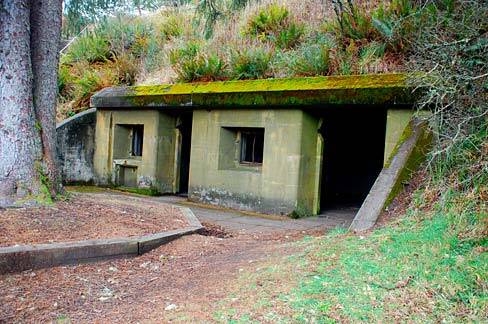In the Historic Fort Stevens State Park, you can probably expect to run into the ghost of a soldier who patrols the area at night with a flashlight. There have been so many stories recounting the encounters that witnesses have had with this fallen soldier, who, when approached ends up disappearing into thin air.
The History of Battery Russel in Fort Stevens
It doesn’t really matter if you have a love for history, architecture, relics of the past, or the supernatural—Battery Russel seems to have it all. While this battery is no longer an active site, it was once of enormous importance in the defense of the Oregon coast during the Second World War. Fort Stevens was originally built around the time of the Civil War—this was when Battery Russel and other ramparts were constructed. It wasn’t until nearly one hundred years later that these ramparts and other structures of Fort Stevens were revived in order to fortify the defense of the Columbia River from a possible invasion during World War II.
Located on-site at the far end of the battery is the Pacific Rim Peace Memorial, which commemorates the American and Japanese soldiers that were involved in the attack on Fort Stevens and called for everlasting peace between these two countries. Despite its importance in the defense of the Columbia River, it was never a favored station of the soldiers who ended up there; it got the unfortunate name of Squirrelsville, due to the fact that many soldiers didn’t want to stay there, possibly because of the quickly built soldiers quarters, and because of the rotations in and out every few days. It wasn’t until after the attack on Pearl Harbor in World War II that Battery Russel was manned full-time.
The Attack on Fort Stevens During World War II
In 1942 on June 21st, at 11:30 pm, an enemy Japanese I-25 submarine attacked Fort Stevens, it had somehow gotten through the mouth of the Columbia River and resurfaced just ten miles offshore. It began its attack by firing haphazardly towards the fort. Fortunately for the soldiers who manned Battery Russel, only a few of the submarine’s missiles landed near to their station, they held their ground and their fire—while the missile fire didn’t injure anyone, it did scare the local population. This led the local communities to set up a citizens patrol, they strung barbed wire up and down Clatsop Beach and even through the Wreck of the Peter Iredale. Oddly enough, this unsuccessful attack was the only action that Fort Stevens saw during the Second World War. This also made it the only mainland military base in the United States to be fired upon since the War of 1812 in which Canadians burned down the White House.
The Function of Battery Russel
One of nine batteries at Fort Stevens, Battery Russel was active for forty years, from 1904 to 1944, where Fort Stevens itself was in active service for eighty-four years, from the beginning of the Civil War all the way through World War II. It was named after Brevet Major General David Russel who fought during the Civil War. While it once protected the mouth of the Columbia River, it was one of three forts that created the Triangle of Fire—the other two being Fort Columbia and Fort Canby in Washington. This three-sided defense made it nearly impossible for enemy boats to go undetected into the Columbia River.

While there are many batteries at Fort Stevens, Battery Russel is one of the few that is open to the public to explore—literature is available on location that educates anyone, who is willing to look into a piece of our past, about the purposes of each of the rooms, as well as the history of the battery itself. There are two levels to this particular battery, the lower of which contains old ammunition rooms, offices, guardrooms, as well as storage facilities. The upper level is where the old gun pit is located, it housed two 10-inch disappearing guns; these guns would retract from view while soldiers reloaded, which provided ample cover from attacking enemies and each gun required a thirty-five man team in order to run.
Even though Battery Russel is an entirely unsupervised location it is well maintained, people are free to explore the historic battery; there is no electricity, so visits during the day are well-light by natural sunlight, but the lower level can become quite dark, so you’re better off carrying a flashlight if you insist on exploring for ghosts.
The Haunting of Battery Russel
The haunting that is described at Battery Russel isn’t exactly one to be feared—because the well-intentioned ghost soldier doesn’t mean any visitors harm, in fact, he was stationed at Battery Russel in defense of the nation and its people. The unidentified army soldier has been seen by many visitors to the Fort, where they report him showing up in several different places in the battery. If the tales are to be believed, this uniformed soldier walks the area—he’s seen wandering around the park, the campgrounds, and more often than not, the concrete battery. Those who have encountered him in the campground report the crunching gravel as he passes the area outside of your tent.
Another commonality between separate encounters is that the apparition of this soldier is that he simply disappears after being spotted. One recollection of an encounter told to the Oregon Coast Beach Connection, was that the witness was walking along the Seaside’s Promenade one night when he saw the army man in a uniform that was reminiscent of the forties. The two men nodded to each other, but when the witness turned to inspect the dated uniform, the army man had mysteriously vanished. To be sure that he hadn’t psyched himself out, the witness even went into the nearby hotel lobbies and asked the reception clerks if an army man had come into their lobby, but after having no luck in locating where the man had gone, the witness was convinced what he had seen was a specter.
Other legends that have popped up about this mysterious soldier are centered around the old guardhouse which is located in a now-residential neighborhood. Residents in the area have caught plenty of, what they believe to be, spirit orbs on camera, while others claim that they have seen him pacing the yard where the museum now stands. Whether this apparition is holding a flashlight and walking the grounds, or he’s holding a knife within the battery itself, no one has ever reported feeling any malicious intent from the spirit.
What is truly curious about this haunting is that no soldiers actually died at Battery Russel, Fort Stevens during World War II, but seeing as it was active during the Civil War, it is believed that he could have been a soldier that passed during that time.

Georgia-based author and artist, Mary has been a horror aficionado since the mid-2000s. Originally a hobby artist and writer, she found her niche in the horror industry in late 2019 and hasn’t looked back since. Mary’s evolution into a horror expert allowed her to express herself truly for the first time in her life. Now, she prides herself on indulging in the stuff of nightmares.
Mary also moonlights as a content creator across multiple social media platforms—breaking down horror tropes on YouTube, as well as playing horror games and broadcasting live digital art sessions on Twitch.

